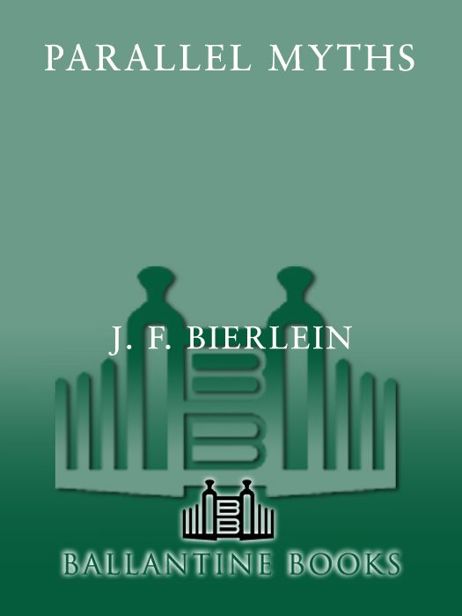Parallel Myths
Authors: J.F. Bierlein



To my mother,
Veronica LaFleur Parrent Bierlein
(1931-1992),
and
Robert G. Hirschfeld
PART ONE: AN INVITATION TO MYTH
3. Beginnings—The Creation Myths
7. Morality Tales from the Myths
9. Some Brief Myths of the Hero
10. The Journey to the Underworld and the Path of Death
11. The End—Visions of the Apocalypse
PART THREE: THE MODERN READINGS OF MYTH
13. Parallel Myths and Ways of Interpreting Them
My sincere thanks to:
My parents, John and Veronica Bierlein, for endless hours of dedicated editing, reading, moral support, and friendship above and beyond the call of parental duty;
My mother in her own right, as she died during the production of this book, for her gift to me of the love of reading and the life of the mind;
Robert G. Hirschfeld, for his consistent friendship and encouragement;
My wife, Heather C. Diehl;
Iris Bass and Lesley Malin Helm, my editors at Ballantine Books, for their assistance, advice, and consistently good humor;
My sister, Cheryl Bierlein Fowler;
Renee, for her encouragement and assistance;
My friends at the Hoyt Library, Saginaw, Michigan: Vi, Fay, Ernestine, Pat, and Kate, among others;
My high school English teachers: Kathy Hughes, John Kiley, Erik Swanson, and Art Loesel, for their introduction to the love of literature;
Many other friends, including Maggie Rossiter of the
Saginaw News
, Sam and Ilona Hirschfeld Koonce, Dr. Steven Hirschfeld, Dr. Bill and Darlene Underhill, and many others.
Myth is an eternal mirror in which we see ourselves
. Myth has something to say to everyone, as it has something to say about everyone: it is everywhere and we only need to recognize it.
This book is for the person who would not normally think about mythology, let alone read a book on the subject. Based on the premise that to understand myths is an important step toward understanding ourselves, it was written as an invitation to the reading of myths and recognizing the mythic in our daily lives.
Throughout the 1980s and into the present decade, popular interest in mythology has been continually on the rise. It is being discovered by a new generation, in the way it has spoken to countless generations past. The popularity of the books of Joseph Campbell, the televised Peter Brook dramatization of the Indian epic
The Mahabharata
, and the prominence of myth in such radio and television programs as “Northern Exposure” are all evidence of this current fascination.
There have been numerous studies of myth and mythology. However, many of them, though fascinating, scholarly, and comprehensive, are written in language not readily accessible to the average thinking reader. They are not presented in a way that speaks directly to the person who is only just discovering the subject. I have felt that a “reader-friendly” approach to the subject is necessary, though it is my hope that my book will not be the last stop in the reader’s exploration of myth, but a first step.
I have been intrigued by mythology since childhood. It began
many years ago when my teacher read to us from Thomas Bulfinch’s
Mythology
, and it grew through my high school and university years, and as I became acquainted with the writings of Joseph Campbell, Mircea Eliade, Paul Ricoeur, and others. This enjoyment has been complemented by a delight in opera; seeing the great myths presented in operatic form has made them more alive and given me new insights.
